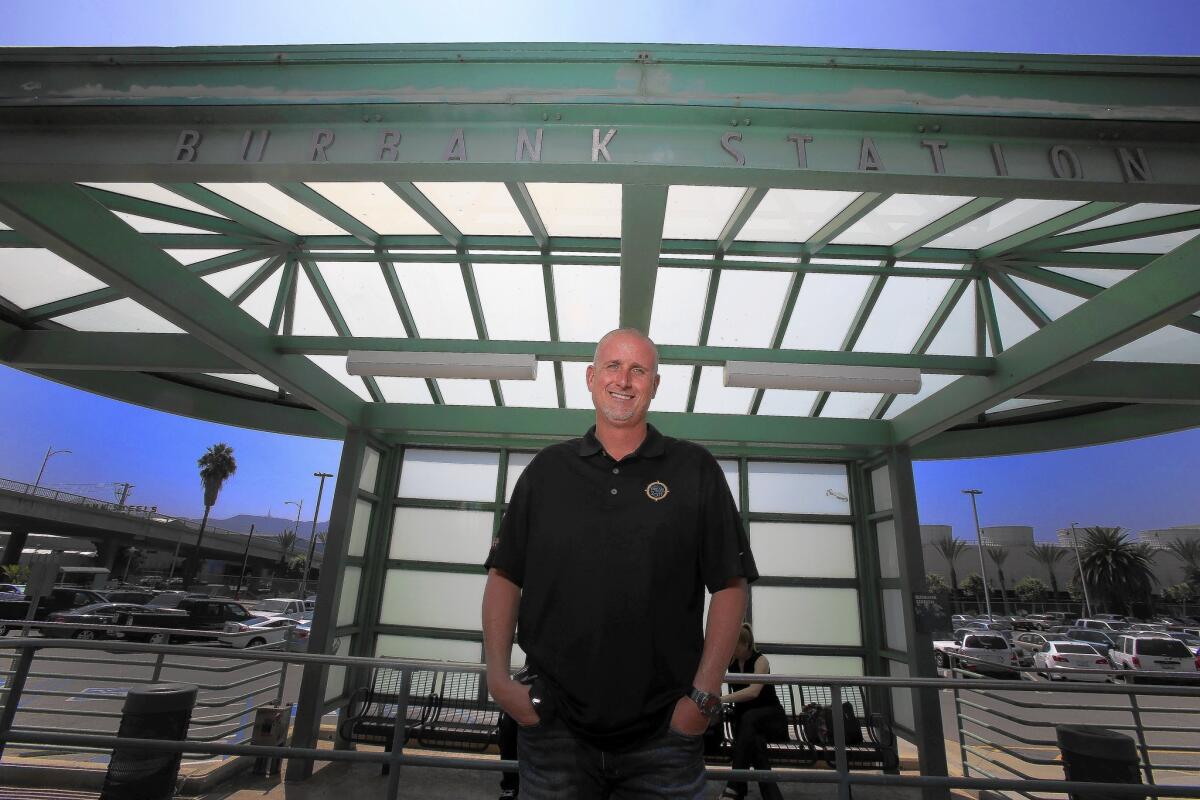Metrolink’s annual ridership continues to drop

- Share via
Sean Robb of Valencia regularly took Metrolink to and from work in Glendale until the trains increasingly fell behind schedule. It became so bad, Robb called the line “Metro-Late.” He now drives to the office.
Levi Gelineau, an insurance salesman, used to ride the line from Simi Valley to Burbank. When fares rose, he bought a Toyota Prius. Now it takes a little more time to get to work, he says, but it’s cheaper than the train.
They are not the only ones who have stopped taking Metrolink.
Once hailed as the fastest-growing commuter line in the nation, the railroad has seen its annual ridership drop by almost 595,000 passengers since 2008, with resulting losses in revenue. That and other factors have left the agency squeezed between trimming service or boosting fares, either of which could prompt more defections.
Officials of the six-county system — covering a region of more than 20 million people — mostly blame the downturn on the worst recession since World War II, which decimated the region’s workforce.
They also note that downtown Los Angeles — the predominant destination for Metrolink commuters — is undergoing a residential renaissance but has faded as an employment center.
“Ridership should be growing given the size of the area Metrolink serves,” said Richard Katz, a former state legislator and longtime board member for the railroad. “Though we have been attracting riders, we’ve had a hard time holding on to them.”
The decline is occurring even though Metrolink has hired experienced marketing professionals, courted employers and tapped into Facebook and Twitter to reach tech-savvy millennials.
Express service, new lines and specialty trains to ball games, rock concerts and the beach have been added. Safety has improved since the deadly Chatsworth crash in 2008, and equipping rail cars with WiFi is planned.
But Metrolink officials, transportation experts and commuters say those measures are working against factors that have steadily chipped away at the railroad’s ridership.
During the recession, the unemployment rate was 8% to 13% across the region and the number of annual boardings dropped from a peak of almost 12.33 million in 2008 to 11.14 million in 2011.
Until that time, Metrolink enjoyed steady growth. By the line’s 10th anniversary in 2002, it had exceeded its ridership goals with almost 8.95 million yearly boardings. The system also had expanded from 112 miles of track in three counties to 512 miles in six counties: Los Angeles, Orange, Riverside, San Bernardino, San Diego and Ventura.
“The recession is a big part of the decline in ridership,” said Robert Turnauckas, chief of marketing and communications at Metrolink. “It’s been hard to recover from something so impactful.”
By 2013 — after then-Chief Executive John Fenton put more emphasis on customer service and building ridership — annual boardings had recovered to almost 12.07 million.
Since then, ridership — contrary to projections — has dropped to 11.74 million. The dip, along with rising costs for fuel, operations and safety projects, prompted the railroad to trim service this year and seek more money from the five county transportation agencies that help fund the line.
Further challenging the recovery, Metrolink officials say, are shifting patterns of job growth across the region.
Studies indicate that the size of the workforce in the core of Los Angeles has stagnated somewhat in the last 20 years while the number of residents has tripled. At the same time, employment has risen in Orange County, the South Bay and on the Westside.
But only Orange County is served by Metrolink, and many new downtown L.A. residents tend to work closer to home and don’t need the rail service.
“The job growth is not that high in downtown Los Angeles,” said Brian Taylor, a professor of urban planning at UCLA. Metrolink’s “ridership is very sensitive to economic change and employment shifts.”
Metrolink officials say the railroad also has been stung by a reduction in the amount of fares that can be deducted from federal taxes and by recent declines in gasoline prices that have encouraged more driving.
Some transportation experts contend that the railroad might be bumping up against the limits of its market — a still-car-dependent region with multiple job centers.
“Transit, especially rail transit, competes poorly in modern, relatively dispersed environments,” said Peter Gordon, professor emeritus of urban and regional economics at USC. “Rail transit best serves areas with dominant downtowns.”
New York, Chicago, Philadelphia, San Francisco, Washington, D.C., and Boston have dominant cores and strong rail traditions. All have commuter trains that carry hundreds of thousands of passengers a day.
Some Southern California commuters say they like riding Metrolink, but the system needs more midday and late-night service. Others have found that express buses can be faster and cheaper. Also figuring into the loss of riders are poorly synchronized train and bus connections.
For almost two years, David Clubb relied on Metrolink to get to his office in Burbank. In the morning, he took a bus to the line’s Simi Valley station, and he did the reverse in the evening.
The bus connection was good going to work, he said, but the return by train was often late.
“There was less than a five-minute window to catch the bus” on the way home, Clubb said. “If you missed it, the wait was 40 to 45 minutes for the next one. Rather than continue to lose time, I was willing to spend $30,000 on a car.”
Although local transportation agencies periodically adjust their bus schedules to match Metrolink’s, the lack of connectivity remains a serious problem, according to Bart Reed, director of the Transit Coalition, a nonprofit organization that supports public transportation.
Some of the most convenient bus and rail connections can be found in Orange County, where the local transportation agency has put a priority on coordinating timetables.
Metrolink officials say they are addressing the synchronization issue and working on other strategies to attract and keep riders, such as the planned Perris Valley Line in Riverside County.
Rail officials cite the creation of a $10 weekend pass that has become popular in the Inland Empire. They say their program for school field trips and partnership with the FlyAway Bus service to Los Angeles International Airport have also generated tens of thousands of boardings.
Michael DePallo, Metrolink’s chief executive, says the effort is paying off. Preliminary figures for July and August show an uptick in riders of about 1.7% compared with the same period last year.
Railroad officials expect more boardings as the Los Angeles County Metropolitan Transportation Authority expands light rail and subway service to the Westside, which will provide commuters better access to job centers and popular destinations there.
To enhance regional travel, work is underway to build run-through tracks at Los Angeles’ Union Station that will allow Metrolink trains to either make shorter stops or pass through the terminal without stopping.
The railroad is now preparing a long-range strategic plan that will evaluate ways to build ridership, including the possibility of reducing fares, an idea supported by Art Leahy, the chief executive of the MTA, which helps fund Metrolink.
As the line weighs its options, Hasan Ikhrata, executive director of the Southern California Assn. of Governments, a regional planning agency, is optimistic. He predicts that ridership will grow as the economy improves, fuel costs rise, major transit projects are finished and car-averse millennials enter the workforce.
“The downward trend is not going to continue,” Ikhrata said.
[email protected]
Twitter: @LADeadline16
More to Read
Sign up for Essential California
The most important California stories and recommendations in your inbox every morning.
You may occasionally receive promotional content from the Los Angeles Times.











